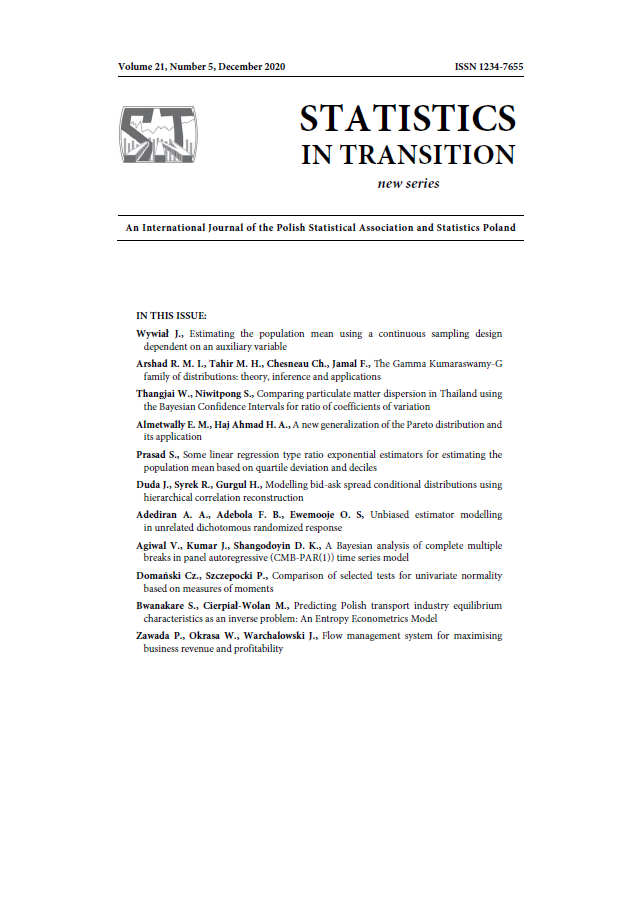ARTICLE
ABSTRACT
This paper introduces a new generalization of the Pareto distribution using the Marshall- Olkin generator and the method of alpha power transformation. This new model has several desirable properties appropriate for modelling right skewed data. The Authors demonstrate how the hazard rate function and moments are obtained. Moreover, an estimation for the new model parameters is provided, through the application of the maximum likelihood and maximum product spacings methods, as well as the Bayesian estimation. Approximate confidence intervals are obtained by means of an asymptotic property of the maximum likelihood and maximum product spacings methods, while the Bayes credible intervals are found by using the Monte Carlo Markov Chain method under different loss functions. A simulation analysis is conducted to compare the estimation methods. Finally, the application of the proposed new distribution to three real-data examples is presented and its goodness-of-fit is demonstrated. In addition, comparisons to other models are made in order to prove the efficiency of the distribution in question.
KEYWORDS
Marshall-Olkin distribution, alpha power transformation, maximum likelihood estimator, maximum product spacings, Bayes estimation, simulation
REFERENCES
AHMAD, H. H., ALMETWALLY, E., (2020). Marshall-Olkin Generalized Pareto Distribution: Bayesian and Non Bayesian Estimation. Pakistan Journal of Statistics and Operation Research, 16(1), pp. 21-33; DOI: 10.18187/pjsor.v16i1.2935.
ALMETWALLY, E. M., ALMONGY, H. M. and EL-SHERPIENY, E. A., (2019). Adaptive Type-II Progressive Censoring Schemes based on Maximum Product Spacing with Application of Generalized Rayleigh Distribution. Journal of Data Science, 17(4), pp. 767-793.
ALMETWALLY, E. M., ALMONGY, H. M., (2019b). Estimation method for new Weibull-Pareto distribution: Simulation and application. Journal of Data Science, 17(3), pp. 610-630.
ALMETWALLY, E. M., ALMONGY, H. M., (2019a). Maximum Product Spacing and Bayesian Method for Parameter Estimation for Generalized Power Weibull Distribution under Censoring Scheme. Journal of Data Science, 17(2), pp. 407-444.
ALMETWALLY, E. M., ALMONGY, H. M. and EL SAYED MUBARAK, A., (2018). Bayesian and Maximum Likelihood Estimation for the Weibull Generalized Exponential Distribution Parameters Using Progressive Censoring Schemes. Pakistan Journal of Statistics and Operation Research, 14(4), pp. 853-868.
ANATOLYEV, S., KOSENOK, G., (2005). An Alternative to Maximum Likelihood Based on Spacings, Econometric Theory 21(02), pp. 472-476.
BDAIR, O., HAJ AHMAD, H., (2019). Estimation of The Marshall-Olkin Pareto Distribution Parameters: Comparative Study, Revista Investigacion Operacional, 41(2), forthcoming.
BJERKEDAL, T., (1960). Acquisition of resistance in guinea pigs infected with different doses of virulent tubercle bacilli, Am J Hyg, 72(1), pp. 130–148.
CHENG R. C. H.; AMIN, N. A. K., (1979). product-of-spacings estimation with applications to the lognormal distribution, University of Wales IST, Math Report 79-1.
CHENG, R. C. H., AMIN, N. A. K., (1983). Estimating parameters in continuous univariate distributions with a shifted origin, J. Roy. Statist. Soc. Ser. B, 45, pp. 394-403.
GHITANY, M. E., (2005). Marshall-Olkin extended Pareto distribution and its application, International Journal of Applied Mathematics, 18, No. 1, pp. 17-31.
GHITANY, M., E., KOTZ, S., (2007). Reliability Properties of Extended Linear Failure- Rate Distributions, Probability in the Engineering and informational Sciences 21, pp. 441-450.
GHOSH, K., JAMMALAMADAKA, S. R., (2001). A general estimation method using spacings. Journal of Statistical Planning and Inference, 93, pp. 71–82.
HAJ AHMAD, H., BDAIR, O., AHSANULLAH, M., (2017). On Marshall-Olkin Extended Weibull Distribution, Journal of Statistical Theory and Applications, Vol. 16, No. 1, pp 1-17.
JOSE, K. K., ALICE, T., (2001). Marshall-Olkin Generalized Weibull distributions and applications, STARS: int. Journal, 2,1, pp. 1-8.
JOSE, K. K., ALICE, T., (2005). Marshall-Olkin Family of Distributions: Applications in Time series modelling and Reliability, J.C Publications, Palakkad.
JOSE, K. K., UMA, P., (2009). On Marshall-Olkin Mittag-Leffler distributions and processes, Far East Journal of Theoretical Statistics, 28, pp. 189-199.
KARIAN, Z. A., DUDEWICZ, E. J., (1998). Modern statistical, systems, and GPSS simulation, CRC press.
KARANDIKAR, R. L., (2006). On the Markov chain Monte Carlo (MCMC) method. Sadhana, 31(2), pp. 81-104.
LAWLESS, J. F., (1982). Statistical Models and Methods for Lifetime Data. John Wiley & Sons, New York.
MAHDAVI, A., KUNDU, D., (2017). A new method for generating distributions with an application to exponential distribution. Communications in Statistics-Theory and Methods, 46(13), pp. 6543-6557.
MARSHALL, A. W., OLKIN, I., (1997). A New Method for Adding a Parameter to a Family of Distributions with Application to the Exponential and Weibull Families, Biometrika, 84(3), pp. 641-652.
METROPOLIS, N., ROSENBLUTH, A. W., ROSENBLUTH, M. N., TELLER, A. H. and TELLER, E., (1953). Equation of state calculations by fast computing machines. The journal of chemical physics, 21(6), pp. 1087-1092.
NASSAR, M., KUMAR, D., SANKU DEY, S., GAUSS M. CORDEIRO, G. and AFIFY, A. Z., (2019). The Marshall–Olkin alpha power family of distributions with applications, Journal of Computational and Applied Mathematics, 351, pp. 41–53.
ROBERT, C., CASELLA, G., (2013). Monte Carlo statistical methods. Springer Science & Business Media.
SINGH, U., SINGH, S. K. and SINGH, R. K., (2014). A comparative study of traditional estimation methods and maximum product spacing method in generalized inverted exponential distribution. Journal of Statistics Applications & Probability, 3(2), p. 153.
KUMAR SINGH, R., KUMAR SINGH, S. and SINGH, U., (2016). Maximum product spacings method for the estimation of parameters of generalized inverted exponential distribution under Progressive Type II Censoring. Journal of Statistics and Management Systems, 19(2), pp. 219-245.
